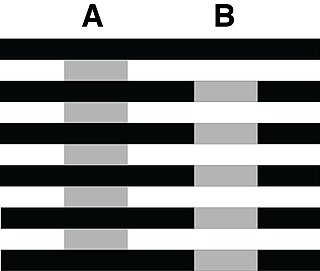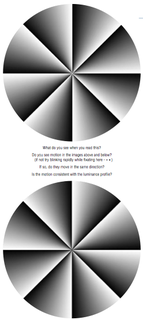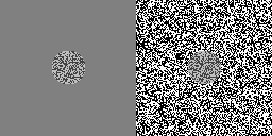Related Research Articles

An illusion is a distortion of the senses, which can reveal how the human brain normally organizes and interprets sensory stimulation. Though illusions distort our perception of reality, they are generally shared by most people.

An optical illusion is an illusion caused by the visual system and characterized by a visual percept that arguably appears to differ from reality. Illusions come in a wide variety; their categorization is difficult because the underlying cause is often not clear but a classification proposed by Richard Gregory is useful as an orientation. According to that, there are three main classes: physical, physiological, and cognitive illusions, and in each class there are four kinds: Ambiguities, distortions, paradoxes, and fictions. A classical example for a physical distortion would be the apparent bending of a stick half immerged in water; an example for a physiological paradox is the motion aftereffect. An example for a physiological fiction is an afterimage. Three typical cognitive distortions are the Ponzo, Poggendorff, and Müller-Lyer illusion. Physical illusions are caused by the physical environment, e.g. by the optical properties of water. Physiological illusions arise in the eye or the visual pathway, e.g. from the effects of excessive stimulation of a specific receptor type. Cognitive visual illusions are the result of unconscious inferences and are perhaps those most widely known.

An afterimage is an image that continues to appear in the eyes after a period of exposure to the original image. An afterimage may be a normal phenomenon or may be pathological (palinopsia). Illusory palinopsia may be a pathological exaggeration of physiological afterimages. Afterimages occur because photochemical activity in the retina continues even when the eyes are no longer experiencing the original stimulus.

The term illusory motion, also known as motion illusion, is an optical illusion in which a static image appears to be moving due to the cognitive effects of interacting color contrasts, object shapes, and position. Apparent motion is the most common type of illusory motion and is perceived when images are displayed in succession at a specific frame rate such as in a movie.
The McCollough effect is a phenomenon of human visual perception in which colorless gratings appear colored contingent on the orientation of the gratings. It is an aftereffect requiring a period of induction to produce it. For example, if someone alternately looks at a red horizontal grating and a green vertical grating for a few minutes, a black-and-white horizontal grating will then look greenish and a black-and-white vertical grating will then look pinkish. The effect is remarkable because, where time-elapse testing is employed, it has been reported to last up to 2.8 months.

The wagon-wheel effect is an optical illusion in which a spoked wheel appears to rotate differently from its true rotation. The wheel can appear to rotate more slowly than the true rotation, it can appear stationary, or it can appear to rotate in the opposite direction from the true rotation. This last form of the effect is sometimes called the reverse rotation effect.

White's illusion is a brightness illusion where certain stripes of a black and white grating is partially replaced by a gray rectangle. Both of the gray bars of A and B are the same color and opacity. The brightness of the gray pieces appear to shift toward the brightness of the top and bottom bordering stripes. This is in apparent opposition to lateral inhibition as it cannot explain this occurrence. This occurs even when the gray patches in the black stripes are bordered by more white than black. A similar illusion occurs when the horizontal strips have different colors; this is known as Munker–White's illusion or Munker's illusion.
Palinopsia is the persistent recurrence of a visual image after the stimulus has been removed. Palinopsia is not a diagnosis, it is a diverse group of pathological visual symptoms with a wide variety of causes. Visual perseveration is synonymous with palinopsia.

The motion aftereffect (MAE) is a visual illusion experienced after viewing a moving visual stimulus for a time with stationary eyes, and then fixating a stationary stimulus. The stationary stimulus appears to move in the opposite direction to the original stimulus. The motion aftereffect is believed to be the result of motion adaptation.

The peripheral drift illusion (PDI) refers to a motion illusion generated by the presentation of a sawtooth luminance grating in the visual periphery. This illusion was first described by Faubert and Herbert (1999), although a similar effect called the "escalator illusion" was reported by Fraser and Wilcox (1979). A variant of the PDI was created by Kitaoka Akiyoshi and Ashida (2003) who took the continuous sawtooth luminance change, and reversed the intermediate greys. Kitaoka has created numerous variants of the PDI, and one called "rotating snakes" has become very popular. The latter demonstration has kindled great interest in the PDI.

Illusory contours or subjective contours are visual illusions that evoke the perception of an edge without a luminance or color change across that edge. Illusory brightness and depth ordering frequently accompany illusory contours. Friedrich Schumann is often credited with the discovery of illusory contours around the beginning of the twentieth century, however illusory contours are present in art dating to the Middle Ages. Gaetano Kanizsa’s 1976 Scientific American paper marks the resurgence of interest in illusory contours for vision scientists.

The Chubb illusion is an optical illusion or error in visual perception in which the apparent contrast of an object varies substantially to most viewers depending on its relative contrast to the field on which it is displayed. These visual illusions are of particular interest to researchers because they may provide valuable insights in regard to the workings of human visual systems.

The barberpole illusion is a visual illusion that reveals biases in the processing of visual motion in the human brain. This visual illusion occurs when a diagonally striped pole is rotated around its vertical axis (horizontally), it appears as though the stripes are moving in the direction of its vertical axis rather than around it.
An empirical theory of perception is a kind of explanation for how percepts arise. These theories hold that sensory systems incorporate information about the statistical properties of the natural world into their design and relate incoming stimuli to this information, rather than analyzing sensory stimulation into its components or features.

The watercolor illusion, also referred to as the water-color effect, is an optical illusion in which a white area takes on a pale tint of a thin, bright, intensely colored polygon surrounding it if the coloured polygon is itself surrounded by a thin, darker border. The inner and outer borders of watercolor illusion objects often are of complementary colours. The watercolor illusion is best when the inner and outer contours have chromaticities in opposite directions in color space. The most common complementary pair is orange and purple. The watercolor illusion is dependent on the combination of luminance and color contrast of the contour lines in order to have the color spreading effect occur.

Neon color spreading is an optical illusion in the category of transparency effects, characterized by fluid borders between the edges of a colored object and the background in the presence of black lines. The illusion was first documented in 1971 and was eventually rediscovered in 1975 by Van Tuijl.
Geometrical-optical illusions are visual illusions, also optical illusions, in which the geometrical properties of what is seen differ from those of the corresponding objects in the visual field.
Oblique effect is the name given to the relative deficiency in perceptual performance for oblique contours as compared to the performance for horizontal or vertical contours.

A phantom contour is a type of illusory contour. Most illusory contours are seen in still images, such as the Kanizsa triangle and the Ehrenstein illusion. A phantom contour, however, is perceived in the presence of moving or flickering images with contrast reversal. The rapid, continuous alternation between opposing, but correlated, adjacent images creates the perception of a contour that is not physically present in the still images. Quaid et al. have also authored a PhD thesis on the phantom contour illusion and it's spatiotemporal limits which maps out limits and proposes mechanisms for its perception centering around magnocellularly driven visual area MT.

Due to the effect of a spatial context or temporal context, the perceived orientation of a test line or grating pattern can appear tilted away from its physical orientation. The tilt illusion (TI) is the phenomenon that the perceived orientation of a test line or grating is altered by the presence of surrounding lines or grating with a different orientation. And the tilt aftereffect (TAE) is the phenomenon that the perceived orientation is changed after prolonged inspection of another oriented line or grating.
References
- ↑ Favreau O.E., Emerson V.F., Corballis M.C.
- Favreau O.E., Emerson V.F., Corballis M.C. (1972) Motion Perception: A Color-Contingent Aftereffect. Science, 7, 78–79.
| This cognitive psychology-related article is a stub. You can help Wikipedia by expanding it. |